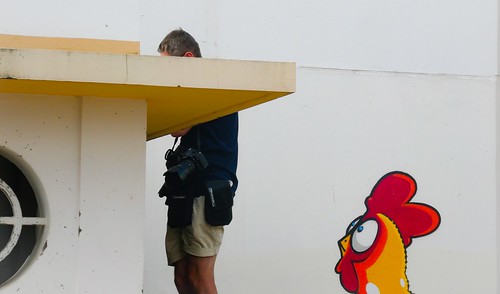Dividing tumour cell population with decreased effects on surrounding normal tissues. As a result this technique provides time for standard cells to repopulate and recover whilst diminishing tumour cells that have aberrantly activated signal transduction pathways. However, sometimes tumour recurs with an acquired radioresistant phenotype posing as an obstruction towards the efficacy of radiotherapy. So as to make radiotherapy far more effective; it truly is significant to explore the radioresistant phenotype in SMER28 cancer cells. Association of various proteins such as p53, Cox2, Ras, pAKT, MDM2, Clusterin, Survivin, Bcl-2 and Mcl-1 with radioresistance have already been reported earlier. On the other hand, so far there isn’t any available tool that can predict radiotherapy MedChemExpress K162 response in oral cancer sufferers leading towards much better therapy. Biomedical application of optical spectroscopic techniques like Fluorescence, Fourier transfer infra-red, Diffused reflectance and Raman spectroscopy for classification of diverse pathological circumstances and cancer detection has currently been reported. Amongst these procedures, RS has added advantages like it truly is label cost-free, sensitive to biochemical variations, applicable to in vitro and in vivo situations, has minimum interference from water and delivers molecular fingerprints. Our preceding studies have demonstrated the efficacy of RS in classifying healthful, premalignant and malignant lesions of oral submucosa; classification of the regular and abnormal exfoliated cells and inside the prediction of tumour response towards concurrent chemo-radiotherapy in cervical cancers. We’ve got shown the possible of RS in identifying early transformation changes in  oral buccal mucosa, its feasibility Raman Spectroscopic Study of 1379592 Radioresistant Oral Cancer Sublines in detecting asthma and determining treatment response via serum in asthma individuals, in classifying normal and oral cancer serum and in identifying multidrug resistance phenotype in human leukemia and uterine sarcoma cell lines. RS research related to radiation induced biochemical adjustments in prostate, lung and breast cancer cell lines irradiated with radiation doses involving 15 and 50Gy are reported. These research were carried out at single doses of radiation that aimed to investigate the in vitro radiation response on human cancer cell lines. On the other hand, we carried out the present study, taking advantage of continuous low 18297096 dose fractionated irradiation routinely utilized as common radiotherapy protocol in clinics for oral cancer remedy. Our aim was to create in vitro radioresistance character within the cell line over a period of time after which explore the feasibility of Raman spectroscopy to categorize the acquired trait from its parental untreated cells. We have established radioresistant oral cancer sublines of buccal mucosa origin by clinical implementable 2Gy fractionated radiation dose. Soon after establishing the sublines, their radioresistant character was evaluated by clonogenic cell survival assay and Raman spectral profiles have been obtained by RS. To the greatest of our knowledge, we’re initial to report the utility of RS in acquired radioresistant oral cancer sublines established from parental oral cancer cell line by clinically administered fractionated ionizing radiation. Components and Procedures Establishment and Characterization of Radioresistant Cell Lines a) Cell culture and establishment of radioresistant sublines by gamma radiation therapy. UPCI:SCC029B, human oral buccal mucosa carcinoma cell li.Dividing tumour cell population with decreased effects on surrounding normal tissues. Therefore this technique gives time for typical cells to repopulate and recover when diminishing tumour cells which have aberrantly activated signal transduction pathways. Having said that, occasionally tumour recurs with an acquired radioresistant phenotype posing as an obstruction towards the efficacy of radiotherapy. In order to make radiotherapy extra successful; it truly is vital to explore the radioresistant phenotype in cancer cells. Association of many proteins which include p53, Cox2, Ras, pAKT, MDM2, Clusterin, Survivin, Bcl-2 and Mcl-1 with radioresistance have already been reported earlier. Nonetheless, so far there’s no accessible tool that may predict radiotherapy response in oral cancer sufferers major towards better therapy. Biomedical application of optical spectroscopic techniques like Fluorescence, Fourier transfer infra-red, Diffused reflectance and Raman spectroscopy for classification of diverse pathological conditions and cancer detection has already been reported. Amongst these strategies, RS has added positive aspects like it truly is label no cost, sensitive to biochemical variations, applicable to in vitro and in vivo circumstances, has minimum interference from water and provides molecular fingerprints. Our earlier research have demonstrated the efficacy of RS in classifying healthy, premalignant and malignant lesions of oral submucosa; classification of your normal and abnormal exfoliated cells and within the prediction of tumour response towards concurrent chemo-radiotherapy in cervical cancers. We’ve got shown the prospective of
oral buccal mucosa, its feasibility Raman Spectroscopic Study of 1379592 Radioresistant Oral Cancer Sublines in detecting asthma and determining treatment response via serum in asthma individuals, in classifying normal and oral cancer serum and in identifying multidrug resistance phenotype in human leukemia and uterine sarcoma cell lines. RS research related to radiation induced biochemical adjustments in prostate, lung and breast cancer cell lines irradiated with radiation doses involving 15 and 50Gy are reported. These research were carried out at single doses of radiation that aimed to investigate the in vitro radiation response on human cancer cell lines. On the other hand, we carried out the present study, taking advantage of continuous low 18297096 dose fractionated irradiation routinely utilized as common radiotherapy protocol in clinics for oral cancer remedy. Our aim was to create in vitro radioresistance character within the cell line over a period of time after which explore the feasibility of Raman spectroscopy to categorize the acquired trait from its parental untreated cells. We have established radioresistant oral cancer sublines of buccal mucosa origin by clinical implementable 2Gy fractionated radiation dose. Soon after establishing the sublines, their radioresistant character was evaluated by clonogenic cell survival assay and Raman spectral profiles have been obtained by RS. To the greatest of our knowledge, we’re initial to report the utility of RS in acquired radioresistant oral cancer sublines established from parental oral cancer cell line by clinically administered fractionated ionizing radiation. Components and Procedures Establishment and Characterization of Radioresistant Cell Lines a) Cell culture and establishment of radioresistant sublines by gamma radiation therapy. UPCI:SCC029B, human oral buccal mucosa carcinoma cell li.Dividing tumour cell population with decreased effects on surrounding normal tissues. Therefore this technique gives time for typical cells to repopulate and recover when diminishing tumour cells which have aberrantly activated signal transduction pathways. Having said that, occasionally tumour recurs with an acquired radioresistant phenotype posing as an obstruction towards the efficacy of radiotherapy. In order to make radiotherapy extra successful; it truly is vital to explore the radioresistant phenotype in cancer cells. Association of many proteins which include p53, Cox2, Ras, pAKT, MDM2, Clusterin, Survivin, Bcl-2 and Mcl-1 with radioresistance have already been reported earlier. Nonetheless, so far there’s no accessible tool that may predict radiotherapy response in oral cancer sufferers major towards better therapy. Biomedical application of optical spectroscopic techniques like Fluorescence, Fourier transfer infra-red, Diffused reflectance and Raman spectroscopy for classification of diverse pathological conditions and cancer detection has already been reported. Amongst these strategies, RS has added positive aspects like it truly is label no cost, sensitive to biochemical variations, applicable to in vitro and in vivo circumstances, has minimum interference from water and provides molecular fingerprints. Our earlier research have demonstrated the efficacy of RS in classifying healthy, premalignant and malignant lesions of oral submucosa; classification of your normal and abnormal exfoliated cells and within the prediction of tumour response towards concurrent chemo-radiotherapy in cervical cancers. We’ve got shown the prospective of  RS in identifying early transformation alterations in oral buccal mucosa, its feasibility Raman Spectroscopic Study of 1379592 Radioresistant Oral Cancer Sublines in detecting asthma and determining therapy response via serum in asthma patients, in classifying normal and oral cancer serum and in identifying multidrug resistance phenotype in human leukemia and uterine sarcoma cell lines. RS research connected to radiation induced biochemical changes in prostate, lung and breast cancer cell lines irradiated with radiation doses in between 15 and 50Gy are reported. These studies have been carried out at single doses of radiation that aimed to investigate the in vitro radiation response on human cancer cell lines. Alternatively, we carried out the present study, taking benefit of continuous low 18297096 dose fractionated irradiation routinely utilised as common radiotherapy protocol in clinics for oral cancer therapy. Our aim was to create in vitro radioresistance character inside the cell line over a time period after which discover the feasibility of Raman spectroscopy to categorize the acquired trait from its parental untreated cells. We’ve got established radioresistant oral cancer sublines of buccal mucosa origin by clinical implementable 2Gy fractionated radiation dose. Immediately after establishing the sublines, their radioresistant character was evaluated by clonogenic cell survival assay and Raman spectral profiles had been obtained by RS. To the ideal of our knowledge, we are initially to report the utility of RS in acquired radioresistant oral cancer sublines established from parental oral cancer cell line by clinically administered fractionated ionizing radiation. Supplies and Solutions Establishment and Characterization of Radioresistant Cell Lines a) Cell culture and establishment of radioresistant sublines by gamma radiation remedy. UPCI:SCC029B, human oral buccal mucosa carcinoma cell li.
RS in identifying early transformation alterations in oral buccal mucosa, its feasibility Raman Spectroscopic Study of 1379592 Radioresistant Oral Cancer Sublines in detecting asthma and determining therapy response via serum in asthma patients, in classifying normal and oral cancer serum and in identifying multidrug resistance phenotype in human leukemia and uterine sarcoma cell lines. RS research connected to radiation induced biochemical changes in prostate, lung and breast cancer cell lines irradiated with radiation doses in between 15 and 50Gy are reported. These studies have been carried out at single doses of radiation that aimed to investigate the in vitro radiation response on human cancer cell lines. Alternatively, we carried out the present study, taking benefit of continuous low 18297096 dose fractionated irradiation routinely utilised as common radiotherapy protocol in clinics for oral cancer therapy. Our aim was to create in vitro radioresistance character inside the cell line over a time period after which discover the feasibility of Raman spectroscopy to categorize the acquired trait from its parental untreated cells. We’ve got established radioresistant oral cancer sublines of buccal mucosa origin by clinical implementable 2Gy fractionated radiation dose. Immediately after establishing the sublines, their radioresistant character was evaluated by clonogenic cell survival assay and Raman spectral profiles had been obtained by RS. To the ideal of our knowledge, we are initially to report the utility of RS in acquired radioresistant oral cancer sublines established from parental oral cancer cell line by clinically administered fractionated ionizing radiation. Supplies and Solutions Establishment and Characterization of Radioresistant Cell Lines a) Cell culture and establishment of radioresistant sublines by gamma radiation remedy. UPCI:SCC029B, human oral buccal mucosa carcinoma cell li.
